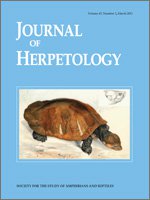In South Africa, particularly Gauteng Province, populations of the large, explosive-breeding Giant Bullfrog (Pyxicephalus adspersus) are suffering increasing habitat loss due to encroaching urbanization. To investigate the spatial habitat requirements of this regionally threatened species, 70 adult frogs were radio- or spool-tracked during five summers around a periurban breeding site. Male and female P. adspersus moved a maximum overnight distance of 350 m when returning to their burrows postspawning. On average, animals of either sex used one long-term burrow (LTB) in a summer. Four males each used a single LTB or burrowing area for two or three consecutive summers. The LTBs of females were situated almost 4 times further (mean = 446.8 m) from the seasonal dams where spawning occurred than those of males (mean = 131.0 m). Female body condition was significantly positively correlated with distance of their burrows from the seasonal dams (rs = 0.77). Limited evidence indicated that adult P. adspersus probably forage mostly within 20 m of their burrows. To protect the LTBs of all radiotracked animals a 950-1,000-m wide buffer would be necessary around the seasonal dams. Because adult P. adspersus seem to be philopatric, juvenile dispersal is predicted to be largely responsible for gene flow among populations.
How to translate text using browser tools
1 March 2011
Conservation Implications of Spatial Habitat Use by Adult Giant Bullfrogs (Pyxicephalus adspersus)
Caroline A. Yetman,
J. Willem H. Ferguson
ACCESS THE FULL ARTICLE

Journal of Herpetology
Vol. 45 • No. 1
March 2011
Vol. 45 • No. 1
March 2011




